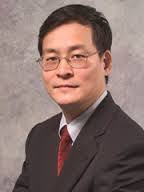
PROFESSOR OF BIOMEDICAL ENGINEERING AND DEPARTMENT CHAIR
TEL:(212)854-6196
FAX:(212)854-8725
EMAIL:exg1@columbia.edu
Ten million Americans suffer from osteoporosis, a gradual weakening of the bones that can lead to fractures, loss of mobility and independence, and depression. Another 18 million suffer from low bone mass. No cure exists for either condition. Doctors simply tell patients to consume enough calcium and vitamin D, to do weight-bearing exercise, and to avoid smoking. Sometimes they also prescribe medications, including bisphosphonates (Fosamax, Actonel, and Boniva), selective estrogen receptor modulators (Evista), or hormones such as parathyroid hormone (Forteo). But all come with side effects, and none are free. The only bone builder on the market, Forteo, costs $8,000 a year and requires daily shots for two years.
X. Edward Guo, director of Columbia’s Bone Bioengineering Laboratory, is trying to figure out how to prevent and treat osteoporosis from both engineering analysis and biological perspectives. To do so, he and his team are analyzing high-resolution 3-D images of bone from both laboratory samples and non-invasive patients’ images to figure out how to better predict fracture risk in patients and monitor efficacy of anti-osteoporosis treatment. With several multi-million-dollar grants supported by the National Institutes of Health (NIH) and working with endocrinologists Drs. Elizabeth Shane and John Bilezikian at Columbia University’s College of Physicians and Surgeons, and Dr. Felix Wehrli at the University of Pennsylvania, they have developed novel imaging analysis and modeling techniques to identify microstructural deteriorations in bone and have translated these technologies in clinical assessments of osteoporosis. Guo and his team also plan to use their knowledge to better understand osteoporosis and bone loss experienced by astronauts in outer space.
During the last two years alone, Guo, as principal investigator, has received four new NIH grants totaling $6.3 million to support his innovative bone bioengineering research. These include a highly competitive NIH Challenge Grant, which was ranked in the top two percent in the review process. This two-year $915,108 grant will support Guo’s work in testing the novel hypothesis that an osteocyte network may function in a similar way as a neuronal network and plays an important role in mechanical memory. The current yearly research expenditure in Guo’s laboratory is over $2 million, one of the top funded bioengineering laboratories in the country.
In the future, Guo and his team hope that doctors can prescribe drugs that would help mature bone cells recruit more bone-forming cells and snub the bone-destroying ones. Such drugs would be a boon to an aging population. After all, women over 50 can lose as much as 20 percent of their bone mass around menopause. Perhaps someday everyone could get drugs at a younger age to prevent later bone loss.
BS, Peking University, 1984; MS, Harvard-MIT, 1990; PhD, Harvard-MIT, 1994